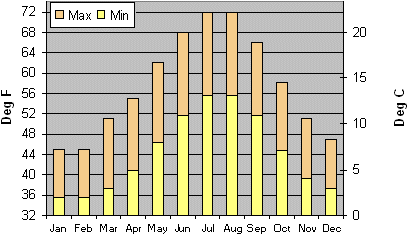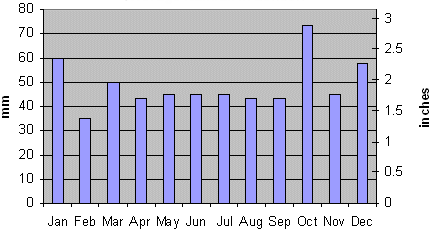 Project Britain
Project Britain
British Life and Culture
by Mandy Barrow
- Search our Site
- Project Britain
- Calendars
- Facts and figures
- London
- Great Britain
- Union Flag
- A-Z of Britain
- Customs & traditions
- Britain today
- Daily Life
- Money
- Etiquette
- Monarchy
- Government
- Education
- Tourist Information
- Food and drink
- Sports and leisure
- History
- Kings and Queens
- Superstitions
- Glossary
|
What is the Climate like in the UK?
|
||||||||||||||||
|
Contrary to popular belief, it DOES NOT rain every day in England or in the rest of the UK! However, it is always advisable to bring some type of waterproof clothing and keep yourself psychologically prepared!
Temperate Climate The overall climate in England is called temperate maritime. This means that it is mild with temperatures not much lower than 0ºC in winter and not much higher than 32ºC in summer. It also means that it is damp and is subject to frequent changes. Warmest and coldest months
Around the coasts, February is normally the coldest month, but inland there is little to choose between January and February as the coldest month.
Best months to travel to England
RainFall Rain is fairly well distributed throughout the year, with late winter/spring (February to March) the driest period and autumn/winter (October to January) the wettest. The Lake District is England's wettest region, receiving and average of 130 inches (330 centimeters) of precipitation each year. The western and northern hills receive about 40 inches (102 centimeters) of rain, while the east coast receives about 20 inches (51 centimetres).
What influences the weather? The main influence on our climate is our close proximity to the Atlantic Ocean, our northern latitude, and the warming of the waters around the land by the Gulf Stream (a warm current of the northern Atlantic Ocean). Our island is small compared with the other land masses in the northern hemisphere – hence Britain is more influenced by the ocean compared with other European countries, and the Gulf Stream helps to keep winters milder compared with other landlocked nations with a similar latitude.
During June, July and August (the months of longest daylight) the mean daily duration of sunshine varies from five hours in northern Scotland to eight hours in the Isle of Wight. During the months of shortest daylight (November, December and January) sunshine is at a minimum, with an average of an hour a day in northern Scotland and two hours a day on the south coast of England. Find out more about the length of daylight through the year |
||||||||||||||||
 © Copyright - please read © Copyright - please read All the materials on these pages are free for homework and classroom use only. You may not redistribute, sell or place the content of this page on any other website or blog without written permission from the Mandy Barrow. |
© Copyright Mandy Barrow 2014
Mandy is the creator of the Woodlands Resources section of the Woodlands Junior website.
The two websites projectbritain.com and primaryhomeworkhelp.co.uk are the new homes for the Woodlands Resources.
Mandy left Woodlands in 2003 to work in Kent schools as an ICT Consultant.
She now teaches computers at The Granville School and St. John's Primary School in Sevenoaks Kent.
Woodlands Junior Homework Help new website
 Britain is an island country and the surrounding sea gives England a varied climate.
Britain is an island country and the surrounding sea gives England a varied climate. July and August are normally the warmest month in England.
July and August are normally the warmest month in England. 
 Probably the best months to travel in England are May, June, September and October. These months generally have the most pleasant temperatures and less rain. July and August are the warmest months, but they are also the wettest. The sunniest parts of the Britain are along the south coast of England.
Probably the best months to travel in England are May, June, September and October. These months generally have the most pleasant temperatures and less rain. July and August are the warmest months, but they are also the wettest. The sunniest parts of the Britain are along the south coast of England. 